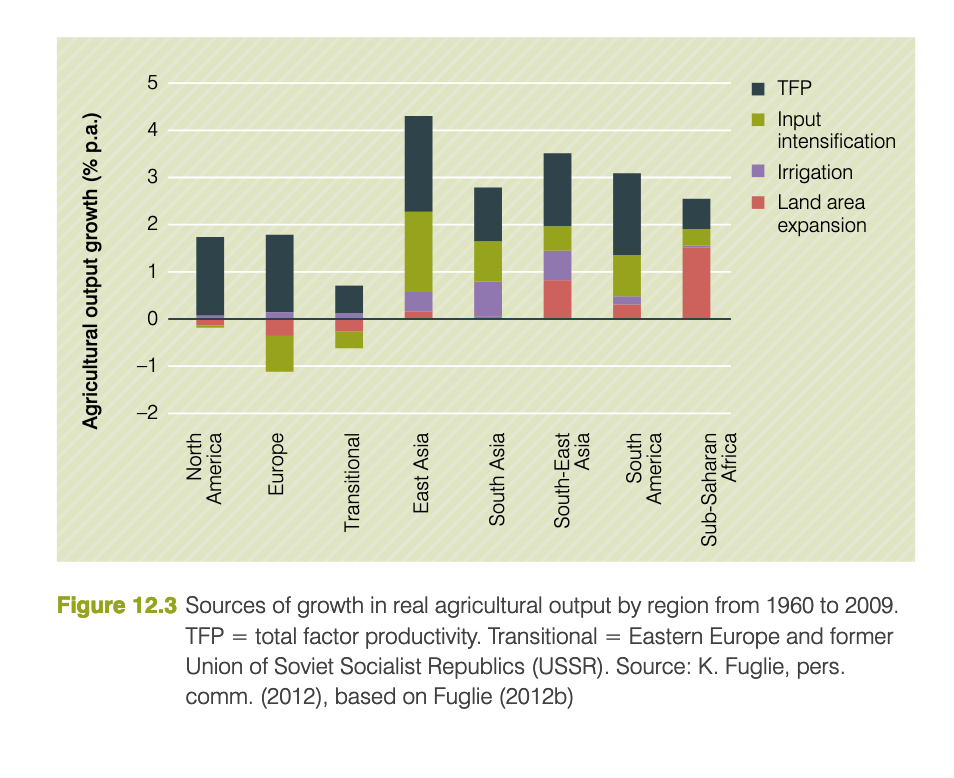Fertilizer use is low in Sub-Saharan Africa
Fertilizer use is low
Maize makes up 30% of SSA's caloric intake, but SSA has seen little improvement in its yields (source: FAOSTAT).


One reason for the low yields might be low fertilizer use. The current amount of fertilizer use in SSA is suspiciously low for three reasons.
First, over the past 60 years fertilizer use has increased very slowly compared to the rest of the world. Globally, fertilizer use has increased from 8 kg/ha in 1960 to 70 kg/ha in 2020. In SSA, coastal countries and countries next to South Africa are reaching >30 kg/ha, but many landlocked countries in the center still have <10 kg/ha.
Second, growth in SSA was fueled by land area expansion while the rest of the world grew through total factor productivity increases (eg efficiency, better seeds) and input intensification (fertilizer, labor). Notably, the Green Revolution in the 1960s created and spread higher-yielding crop varieties through Asia and South America that were able to use much higher amounts of nutrients to increase yield. (Yield due to better seeds are captured in TFP.)

Third, most SSA countries are inefficiently using soil nutrients. We can try to understand this by looking at nitrogen use efficiency: the ratio of output nitrogen (N in crop harvest) to input nitrogen (N in manure, synthetic fertilizer, symbiotic fixation and atmospheric deposition). If nitrogen use efficiency is above 100%, there is a net deficit of fixed nitrogen.
The International Fertilizer Association notes that as countries develop their yield efficiency, we see nutrient use efficiency drop and then increase:

Where are SSA countries on this curve? I don't think any are in the green area. Efficiency in SSA countries seems pretty variable. The few countries that have high application rates are <60% efficiency. Most other countries are >100% or <60% efficiency.

Fertilizer use is low. Intuitively, this is hard to rationalize. Fertilizer is well-known. Fertilizer is divisible and useful in very small quantities so there aren't barriers to access; once you use a little, you generate more profit and can fuel the positive-feedback loop. Why don't we see positive feedback loops?
Supply: what affects fertilizer price?
How much does urea cost in SSA? I've picked three countries (Nigeria because they produce a urea surplus, Kenya because they don't but they're a coastal country, and Zambia because it's a land-locked country).
| Lagos, Nigeria | Mombasa, Kenya | Lusaka, Zambia | |
|---|---|---|---|
| FOB | $20 (factory price) | $17.63 | $17.63 |
| Ocean Freight | $0 | $3 | $0 |
| Clearing | $0 | $2 | $1.81 |
| Bagging | $0 | $0.50 | $0.89 |
| Warehousing | $0 | $1 | $0.92 |
| Financing | ? | $1.60 | $7 |
| Road Freight | $3.10 | ? | $7 |
| Total | $23.06 | $26.06 | $35.43 |
Prices are in USD/50kg bag of urea. These are surveyed retail prices. Data is from Aug 2023, from africafertilizer.org.
This doesn't seem high enough to explain the low fertilizer usage. Total retail prices were ~$25 in the US and ~$20 in China. Though I bet costs grow much higher if we go further inland where logistics infrastructure is much less built out.

Demand: what affects farmers' decision to buy fertilizer?
That is, why do SSA farmers have their current levels of demand for fertilizer? Why not higher? Why not lower? That is, at the current prices, why don't farmers buy eg 2x fertilizer?
I've started exploring that in the next post: What influences fertilizer demand in Sub-Saharan Africa?